Menhir - Single Driver Speaker
Introduction
Working on the fullrange transmission line (TML) speaker with Manger's Bending Wave Transducer MSW, I made numerous simulations using AjHorn. While the first TML speakers perform very well and the feedback of several friends and music lovers has been encouraging, the construction is rather complicated and time-consuming.
So, I was looking for alternative designs with a similar performance but with less complexity concerning the overall construction. I started to scrutinize the different topologies of enclosures by using AjHorn and my experience.
Although I know it is extremely difficult, if not impossible, to adequately cover the audio band with only one driver, today I am convinced that this transducer, well applied, is one of the best drivers in the frequency range of 90 Hz to 24 kHz and in my opinion well qualified for a fullrange system.
The Driver
Manger's MSW driver has a flat diaphragm which is bent to produce sound waves, rather than pushed and pulled like a regular "rigid" speaker cone.
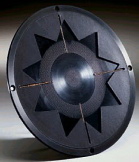
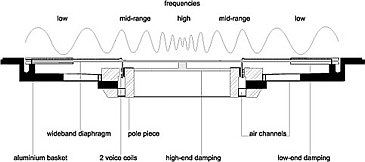
Manger WO5 - Copyright manger-msw.com
Below you will find the Thiele/Small Parameters for the neodynium magnet. Please note that the validity of Thiele/Small Parameters (TSP) is limited. Above 200 Hz the TSP no longer are valid.
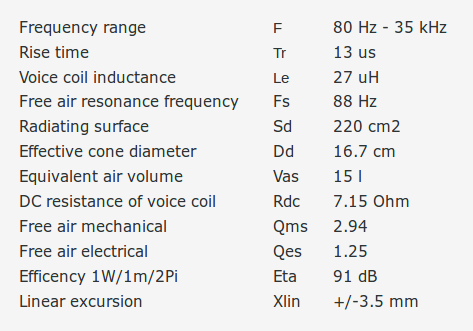
Manger WO5 Thiele/Small Parameters Consistency Check 
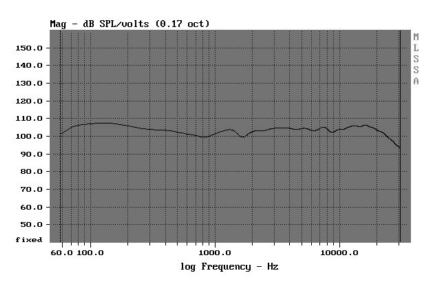
Manger WO5 Frequency Response - Copyright manger-msw.com
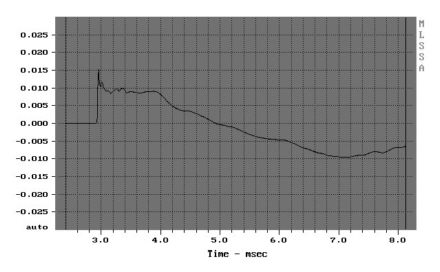
Manger WO5 Step Response - Copyright manger-msw.com
Design Topologies
As mentioned at the beginning of this article, after numerous simulations done, I selected two alternatives: a transmission line solution and a multiple vented solution!
The simulations are guided on the Mirrored sound pressure response as a basis for loudspeaker design discussed in the chapter Loudspeakers - Listener Friendly Sound Pressure Response for a 25 to 30 cm front baffle width.
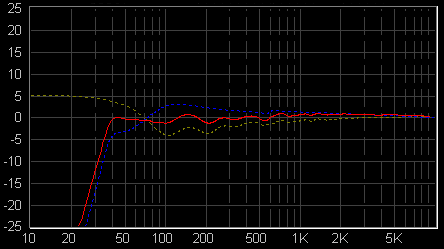
brown dashed line = Combined response of normalised room sound pressure
response and baffle diffraction loss for a baffle between 25 to 30 cm
blue dashed line = Adapted 2 Pi loudspeaker frequency response
red line = Resulting in room sound pressure response
TML Menhir : Transmission Line Solution
Although this solution may not be a classical transmission line design, the main characteristics of a transmission line still remain.
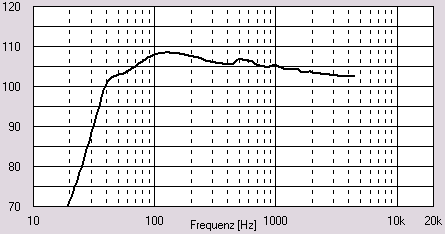
2 Pi Frequency response at 32W power input in "db"
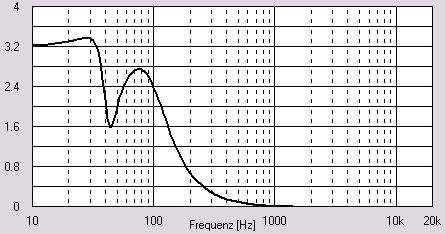
Voice coil excursion in "mm" at 32W power input
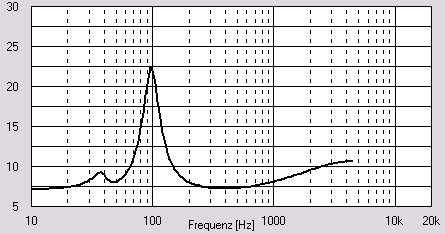
Impedance curve in "ohm"
Simulation:
- Rear chamber volume : 24 liters
- Throat area : 1500 cm2
- Mouth area : 70 cm2
- Line lenght : 75 cm
- Line flare : Parabolic
- Box volume : 80 liters
- Acoustic termination : Fibrous stuffing material
- Box leakage Ql : No leakage, Ql > 30
- Effective Qt : approx. 0.9
Advantages:
- Acceptable box volume
- Very simple design and straightforward construction
- Comes close to the room and listener friendly sound pressure response
- To some extend adaptable to room acoustics (at the expense of varying the frequency ripples and maximal power input)
Disadvantages:
- Not very nice frequency response ripples
- Small TML port may cause air flow noise at high SPL levels
- Mandatory use of ordinary fibrous stuffing material
- Stuffing of the line may cause losses in bass detail
- TML and box tuning may be delicate
Drawing Overview:
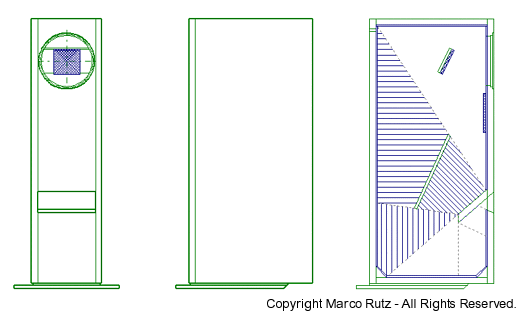
Construction Plan : TML Menhir 1a 
Bill of Materials:
- Loudspeaker : Manger WO5/1-2.2.16
 , neodymium, 8 ohm
, neodymium, 8 ohm - Box walls : 24mm birch multiply plywood
- Line damping material : sheep long-fiber wool or Acousta-Stuf Polyfill
- Line damping density : approx. 75% to 150%
- Chamber damping : none
- Box wall damping : 5mm Idikell 4001
 and 10mm wool felt
and 10mm wool felt - Box base : 12mm to 16mm marble, granite or slate
- Base damping (between enclosure and base): high density cork
AMV Menhir : Aperiodic Multiple Vented Solution
This solution has a regular and an aperiodic port.
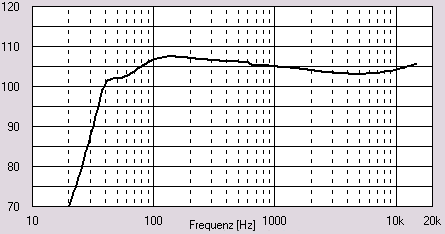
2 Pi Frequency response at 32W power input in "db"
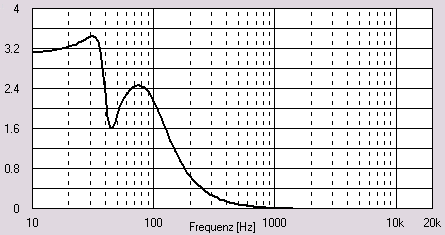
Voice coil excursion in "mm" at 32W power input
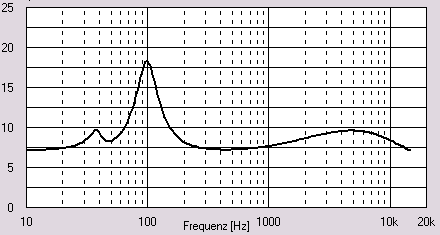
Impedance curve in "ohm"
Simulation details:
- Volume of all "four" rear chambers : 78 liters
- Throat area : 120 cm2
- Mouth area : 120 cm2
- Port lenght : 14 cm
- Port flare : slightly conical
- Box volume : 80 liters
- Acoustic termination : sound diffusing and aperiodic port
- Box leakage Ql : aperiodic, Ql = 3.5 to 4.0
- Aperiodic port area : approx. 45 to 50 cm2
- Effective Qt : approx. 0.82
Advantages:
- Acceptable box volume
- Comes very close to the room and listener friendly sound pressure response
- Simple design and straightforward construction
- No ugly frequency response ripples
- To some extent adaptable to room acoustics (at the expense of varying the max. power input)
- No need of fibrous stuffing materials
Disadvantages:
- Mandatory use of recommended materials
- Expensive
Drawing Overview:
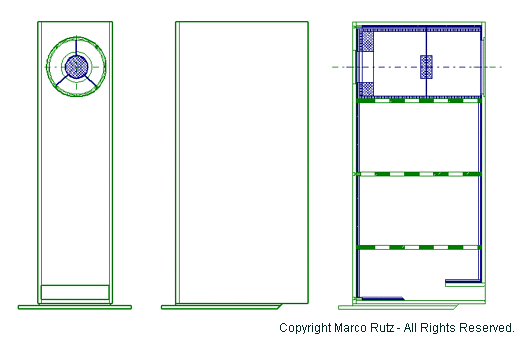
Construction Plan : AMV Menhir 2b, 14/2/2005 
Bill of Materials:
- Loudspeaker : Manger WO5/1-2.2.16
 , neodymium, 8 ohm
, neodymium, 8 ohm - Box walls : 24mm birch multiply plywood
- Chamber damping : aperiodic and diffusion
- Main port damping : none
- Aperiodic port damping material : very thin felt
- Box wall damping : 5mm Hawaphon
 and 5mm Idikell 4001
and 5mm Idikell 4001 
- Diffusion : 10mm Aramid Honeycomb
 , 40mm Water Filter 20 PPI
, 40mm Water Filter 20 PPI 
- Box base : 16mm to 20mm marble, granite or slate
- Base damping (between enclosure and base): 5mm high density cork
Along with the effort of designing the AMV Menhir 1a, I considered another solution which may have an improved performance. This alternative design is more complex, more difficult to build and therefore also more expensive.
Construction Plan: AMV Menhir Study 
